Choppers are as American as Chevrolet, apple pie and Homer Simpson. With lengthy wheelbases deserving their own zip codes, choppers stake a major claim in our motorcycle landscape. Indeed, American bike builders have been chopping and customizing bikes for years, and when the movie Easy Rider played on the silver screen in 1969, the long bikes etched their place in American bike lore for good.
So what are the two leading Japanese motorcycle brands doing, producing what appear to be American choppers? Good question, and the answer can be found in the economic side of the motorcycle business equation. Several years ago when cable television programming grew top-heavy with biker build-off shows, choppers regained their former stature among enthusiasts.
The rekindled interest in choppers fueled a fledging cottage industry of builders, ranging from small back-alley shops with sinister names like Darkside Customs and Wicked Bros. Choppers to major brands such as Big Dog Motorcycles, American IronHorse and Titan that offered hundreds, even thousands, of ready-made custom bikes for sale. By 2008 even Harley-Davidson joined in with the Rocker C, a model that represents the Motor Company’s version of a turnkey chopper.
We all know that the chopper boom went bust with the economy a few years ago (Big Dog Motorcycles was the last major brand to go out of business, mercifully being put down earlier this year), but by that time Honda and Yamaha were committed to their respective chopper programs. Their resources already committed to making new chopper models, they forged ahead anyway. Honda’s turnkey chopper, the Fury, was first to the market, leaving the chopping block in time for model year 2010. Yamaha Star’s Stryker was next, bowing earlier this year.
That brings us to our chop-off that pits these two Samurai warriors on American soil. Which of the two Japanese brands offers the better American chopper? We ventured to find out, and perhaps the most appropriate place to begin is with the first entry, Honda’s Fury.
2012 Honda Fury VT1300CX
First thing’s first, so let’s cut to the chase: choppers give credence to the old saying, “form over function.” Foremost, choppers are about style and being (and looking) cool. Long wheelbases, enough chrome parts to outshine a 1958 Buick Roadmaster, and laid-back ergonomics create a ride that looks oh-so cool. Handling, braking, even acceleration performance are secondary.
Based on its form alone, the Fury scores highly. Viewed from 10 or so feet away the Fury, straddling an incredible 71.2-inch wheelbase, appears to be a bike that was hand-built by someone who knows his craft.
The Fury’s sexy silhouette has all the lines you expect in a high-neck chopper: an extended front end creates a spacious void that allows the engine to be a predominant aesthetic fixture in the overall package, the exhaust system follows the bike’s lower lines such that it blends gracefully alongside the rear disc brake, and most of all the svelte gas tank’s curves flow from the frame’s backbone into a sculpted seat that practically melds with the Fury’s seductively large rear fender.
The frame rails are clean and purposeful, too, as if Honda’s workers employed the age-old trick established by early chopper builders, using plastic body filler to conceal unsightly weld joints. Oddly, though, there are a few weld scars at the top of the downtubes that could have been eliminated but weren’t.
Even the Fury’s 1312cc liquid-cooled V-Twin engine’s radiator is positioned neatly between the frame’s two downtubes so that the coolant hoses appear practically nonexistent. There is no ungainly radiator grille work, either; a small black plastic shroud is all that shields the radiator fins from road debris.
That’s not the only plastic component you’ll find on the Fury, though. In fact, if Honda ever ups the production run for the Fury, there’s a strong chance that the international price for plastic futures will increase, too. This bike has more plastic than a Lego toy. Both fenders, stylish as they are, are plastic, many engine cases and covers are made of specially chrome-plated plastic, and the chromed cosmetic side covers are made of that 20th century discovery, too.
Although the Fury’s plastic fenders are uncool for this class,” Ed-in-Chief Duke observes, “the Honda shows much better attention to detail, especially its high-neck frame, stylish headlight and very attractive wheels.”
Production costs no doubt played a factor in using plastic instead of metal, but liberal use of the lightweight material also helps keep the bike’s overall weight down. Strangely, though, while the Stryker relies on that old-fashioned material called steel to serve many of the same styling purposes, that bike weighs about 20 pounds less (663 pounds for the Fury versus the Stryker’s 646 pounds) than the Honda. The weight difference can probably be found in the drive-trains; the Fury has a drive shaft that requires abundant use of metal while the Styker calls on a lightweight synthetic-composite belt to transfer power to the rear wheel.
Styling and plastic aside, the Fury and Stryker share a common bond in terms of their engines’ pulling power, even though the Star’s slightly smaller V-Twin produces about 10 more horsepower on the Cycle Doctor’s dynamometer.
In top-gear roll-ons at 70 mph the bikes finished in a near dead heat. Not that either of these customs are road warriors in the performance sense, but their V-Twin engines pull smartly from near idle to their respective redlines. The edge in throttle response goes to the Styker, though, delivering a slightly snappier feel when rapping through the gears, but this comes with a small price of a herky-jerky feel at the throttle’s initial opening.
You can expect respectable fuel mileage figures, too, from either bike. Depending on how you treat the right-hand grip, miles per gallon figures range from the upper 30s to the low-to-mid 40s. Vibration is minimal, and the Fury’s exhaust note especially got our attention. True, the mufflers are visually thicker in their mid sections than what most real chopper riders prefer, but Honda had to deliver them to dealers as EPA-compliant cans, which accounts for their rather unsightly bulkiness. Even so, the Fury’s exhaust tone is pleasant and it gets your attention – you know, the way chopper pipes are supposed to do.
As noted, ride, handling and overall performance are secondary aims when it comes to building a custom chopper motorcycle. Same holds true with these factory specials, but after a ride across town or through the local countryside, the Fury and Stryker won’t disappoint you.
The Fury, especially, makes you feel like a bad-ass chopper bro. Swing a leg over its sculpted seat and grab the pullback handlebar grips, and first thing you notice is that your body assumes what can best be described as the “chopper slouch.”
You’ve seen it on chopper bros who have ridden by on their bikes – the rider’s back gently curves so that his head leans slightly forward, with arms reaching straight ahead, almost paralleling legs that rest their feet on forward foot controls. This posture has a magical feel about it, and you really don’t care anymore about how fast, or slow, you accelerate from the stoplight, driveway or local roadhouse. You just motor away, feeling oh-so bad and oh-so cool. You’re Peter Fonda, Marlon Brando and Sonny Barger all in one.
It gets better. When you roll to a stop and you place your feet onto the pavement, that cool feeling doesn’t dissolve and fade away. The lope of the Fury’s 52-degree V-twin engine entertains your aural senses, but you know the real show is the visuals that people curbside or in the car next to you are enjoying. You’re bad.
You’ll notice something else when you roll to a stop. The Fury requires steady pressure on the skinny brake lever and foot pedal to slow it down. Two-piston calipers (one up front, one on the rear) will properly slow and stop the Fury, but feedback is vague and uninspiring.
Now let’s talk about the Fury’s most striking feature, its extended front end. Choppers originally acquired their name because the builders attached extended fork legs to the bike’s triple trees. But doing so raised the front section of the bike, creating all sorts of handling issues. To regain respectable handling, the frame needed to be lowered at the front, and the solution was to cut – or chop – a wedge out of the steering neck so the builder could reposition (sometimes called “raking”) the fork angle.
Cutting and welding the steering head like that lowered the bike, plus it helped retrieve some of the lost trail, minimizing fork flop. This is a condensed version of what it took the chopper pioneers years to figure out, but in Honda’s case they simply determined what steering head angle (38 degrees) and trail dimensions worked best with the 21-inch front wheel, and then built the frame and fork length accordingly. Again, this is a simplified interpretation of what Honda’s engineers accomplished, but you get the idea.
“The Stryker’s 120/70-21 front tire offers more security than the pizza-cutter 90/90-21 on the Fury” Duke remarks. “The Fury’s narrow front tire gets distracted by longitudinal freeway rain grooves.”
Honda also managed to deliver a low seat height that places your butt just 26.7 inches off the deck. It’s part of the cool factor we talked about earlier, but it also should help sell more than a few of these bad-boy bikes to riders who are vertically challenged.
The lower seat height also helps maintain a low center of gravity. Coupled with proper steering geometry, this chopper is rather easy to maneuver around town. There’s no noticeable fork flop, and u-turns on a two-lane road are doable. There’s uneasiness to the Fury’s handling, though, when that long wheelbase encounters bumps and dips in the road, most noticeably while making or initiating turns. Be careful, too, about how far you lean the bike into the turn – the forward foot controls easily touch the pavement.
In terms of ride and handling, the Fury’s primary shortcoming is found in its suspension. Smooth road surfaces allow it to maintain a friendly ride, but a series of rapid bumps in the road often confuse the Fury’s damping rates, and you’ll experience some harshness from the fork. The ride won’t shake your dentures loose, but it’s not as pleasant as most cruisers. Perhaps we should check it off as part of the chopper experience and leave it at that.
And, indeed, the chopper experience is really what the Fury is all about. Its curbside appeal is striking, making you look and feel like a biker outlaw, yet this long bike will get you to and from your ride destination in relative comfort. In more than one sense, we’ve come a long way, baby!
“Both bikes deliver the requisite chopper profile, with V-Twin engines placed in high-neck frames and led by a tall front wheel,” Duke notes. “But the Fury pulls off the costume much more convincingly than the dowdy-in-comparison Stryker. However, the Honda’s pretty appearance comes at a hefty price.”
2011 Yamaha Star Stryker
Star Motorcycles took a less conventional approach than did Honda for its chopper. While Honda’s Fury favors the traditional high-neck style that’s typically associated with the great American chopper, Star applied some styling cues generally associated with pro-street choppers, a breed that has its roots in San Francisco Bay area where many custom bike builders gave their bikes long, low and lean stances.
During the 1970s and 1980s bike builders like Arlen Ness and Ron Simms honed this styling theme to create what became known as the Frisco chopper, bikes with exceptionally radical steering head angles. At about that same time the pro street class was gaining popularity at the drag strips across the country, and eventually the Bay Area choppers formed the vanguard for what became the pro street look for custom motorcycles. It’s a look that remains popular today.
The Stryker employs many of the pro street elements, but with a few modern touches added. For instance, the 41mm fork legs utilize the latest damping technology, and a low-profile 210-series rear tire fills an equally wide rear fender (like the front fender, it’s made of steel). Pullback handlebars offer a more upright seating position for the rider, and forward foot controls sprout from the lower frame rails.
But while Honda successfully incorporated American chopper heritage into the Fury, the Star designers fell short of delivering as impressive and cohesive a package.
In terms of appearance, the Styker seems disjointed and cluttered, as if the bike had been designed by committee, each designer given a single task but without being privy to what the other committee members were assigned.
To appreciate this, check out the right side where the gas tank and air cleaner box vie for attention. Viewed as individual components, the gas tank and air cleaner box offer clean, aesthetic lines, but when positioned together on the bike, the tandem comes across as an afterthought.
Indeed, the Styker and Fury share similarly shaped and sized air cleaner covers, but while the Honda’s box seamlessly integrates with the rest of the bike, the Star’s chromed triangular-shaped box seems to just dangle alongside the engine. And above the Stryker’s airbox the stylish peanut-style gas tank looks as if it were unceremoniously placed on the frame’s backbone rail.
The same applies to other components on the Styker. The horn clings obtrusively to the right forward foot control, and an unsightly emissions-control can protrudes from the left foot control. Weld joints in the frame (including the all-important steering head weld joints) are concealed with black plastic covers, and the paint finish on our test bike’s rear fender showed signs of fish-eye under certain lighting conditions.
Despite these styling shortcomings, the Styker’s ride and handling is above what most other cruisers can deliver. The suspension is taut, with good feedback to the rider, and steer-in for turns is predictable and rather precise, although steering feels heavy at low speeds, probably a byproduct of the wide front tire and excessive fork angle. Even so, the fork does a good job of soaking up the bumps, and the spoon-shaped seat offers plenty of support – much more than does the Fury’s.
“The Fury’s lower seat feels cooler,” Duke opines, “but the Stryker’s broader and better-padded seat is a preferred perch for longer distances.”
And after you plop your behind on the Styker’s seat and place your hands and feet on the controls, you’ll be treated to a more conventional riding position than what the Fury offers. In fact, our test riders agreed that it feels more like you’re sitting in the Fury, and on the Styker.
Each riding position has its pluses, too; the Fury’s high gas tank and steering neck serve as a windbreak at high speeds, while the Styker’s stance seems to give the rider a better feel for the bike while cornering and maneuvering through tight places.
Same holds true under braking conditions. Like the Fury, the Styker has single disc brakes front and rear, but while the Fury’s anchors felt vague, with minimal feedback, the Styker’s brakes delivered a more positive feel. Both braking systems brought our test bikes to smooth and controlled stops, we just preferred the feel of the Styker’s progressive feedback more.
“The Star’s front brake offers better speed retardation than the Fury,” Duke says, “due partially to the bigger contact patch of its wider front tire.”
Oddly, though, while Star predicts that about a third of its Stryker customers will be women, the bike is equipped with more manly Harley-like clutch and front brake levers. On the other hand (pun intended), the Fury’s levers felt small and wimpy, as if they were developed for smaller hands.
“The Stryker’s wide dogleg levers feel appropriately butch,” Duke says. “In contrast, the Fury’s narrow brake and clutch levers feel inadequately beefy for a bad-ass motorcycle.”
In the mechanical department, the Fury and Stryker are the same only different. The Fury’s V-Twin engine’s three-valve cylinders are set at 52 degrees while the Stryker’s are splayed slightly wider at 60 degrees. Displacement is closely the same, too, and interestingly they share about the same displacement as Harley-Davidson’s Evolution V2, an engine that powered Milwaukee’s Big Twin models from 1984 through 1999 and 2000 when the current Twin Cam and Twin Cam B debuted respectively.
These Japanese V-Twins deliver power in smooth, broad strokes, but the Styker’s four-valve-per-cylinder engine clearly revs quicker and higher than does the Fury. Bore and stroke dimensions are a major factor here: the Fury gets its 1312cc displacement from bore and stroke figures of 89.5mm by 104.3mm, while the Stryker checks in with practically the opposite stats of 100mm x 83mm, resulting in 1304cc.
The shorter-stroked Styker peaked at 5600 rpm (67.6 hp; maximum torque of 75.0 ft-lb at 3700 rpm) while the Fury reached its maximum horsepower (57.3) at a more lazy 4300 rpm (with 72.9 ft-lb of torque at 3600 rpm). As noted, vibration isn’t a major issue with either bike, and roll-on power is nearly equal.
Like the Fury’s transmission, the Stryker’s five-speed box shifts smoothly and positively. There was, however, a slight notchy feel from first to second gear during up-shifts, otherwise it’s the same smooth-shifting set of gears that you expect from Star.
Despite some shortcomings in its style and finish, the Stryker is a custom cruiser – a chopper, if you will – that delivers the goods as promised. Its strong point, though, is in how it delivers the goods to the rider, making it one of the better choppers for enthusiasts who like to ride.
“The Stryker’s belt-drive system is lighter and has less driveline lash,” Duke says, “plus it’s capped by an attractive rear pulley.”
Source : motorcycle.com










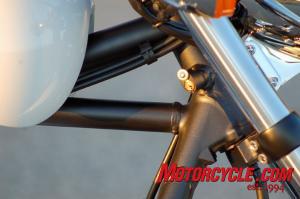
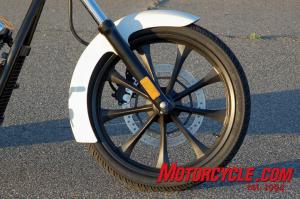
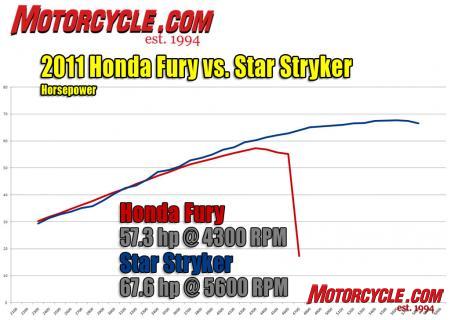
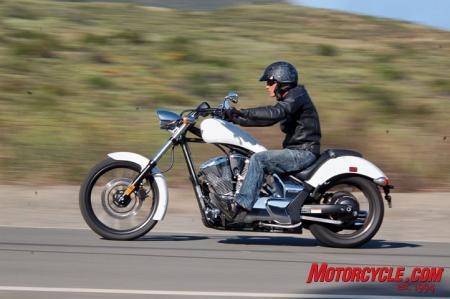
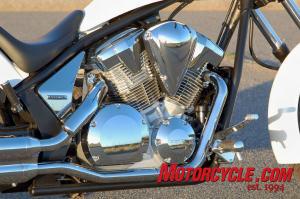
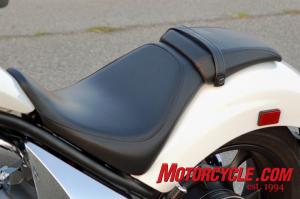
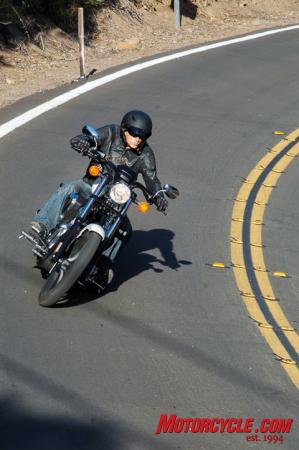
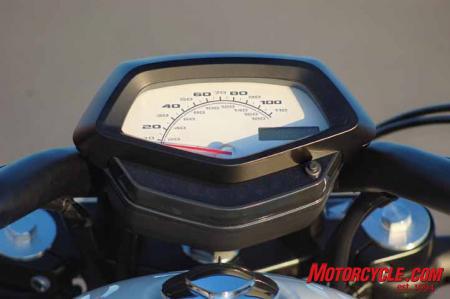








0 comments:
Post a Comment